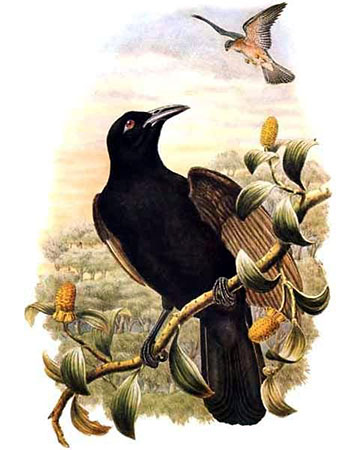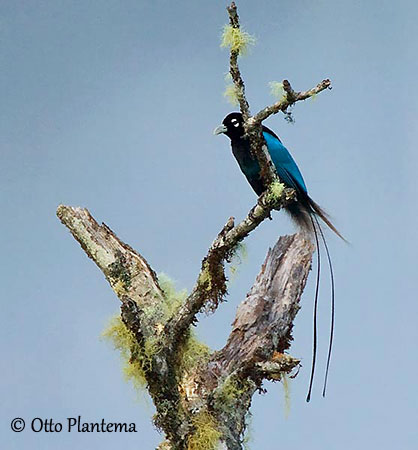
Text by Nicole Bouglouan
Photographers:
Patrick Ingremeau
TAMANDUA
Otto Plantema
Trips around the world
Dubi Shapiro
Dubi Shapiro Photo Galleries
Illustrations:
Richard Bowdler Sharpe (1847-1909)
These images and the text are subject to copyright and cannot be used without express authorization from the owners. Legal issues
Sources:
HANDBOOK OF THE BIRDS OF THE WORLD Vol 14 by Josep del Hoyo-Andrew Elliot-David Christie - Lynx Edicions – ISBN: 9788496553507
Birds of Paradise and Bowerbirds De Phil Gregory – Editeur: Bloomsbury Publishing, 2020 – ISBN: 1472975847, 9781472975843 – 416 pages
Les Oiseaux de paradis – Histoire Naturelle et photographies - par Michel Ottaviani - Editions Prin, France – ISBN : 2-909136-40-X
Birds of New Guinea: Second Edition De Thane K. Pratt, Bruce M. Beehler – Editeur: Princeton University Press, 2014 – ISBN: 0691095639, 9780691095639 – 528 pages
Birds of New Guinea: Distribution, Taxonomy, and Systematics De Bruce M. Beehler, Thane K. Pratt – Editeur: Princeton University Press, 2016 – ISBN: 069116424X, 9780691164243 – 672 pages
Book of Curious Birds De Jennifer Cossins – Editeur: Hachette UK, 2021 – ISBN: 073442048X, 9780734420480 – 64 pages
Astonishing Animals: Extraordinary Creatures and the Fantastic Worlds They ... De Tim Flannery – Editeur: Open Road + Grove/Atlantic, 2012 – ISBN: 0802194176, 9780802194176 – 192 pages
Bird: The Definitive Visual Guide De DK – Editeur: Dorling Kindersley Ltd, 2022 – ISBN: 0241596319, 9780241596319 – 512 pages
Birds of the World publié par Jason A. Mobley – Editeur: Marshall Cavendish, 2008 – ISBN: 0761477756, 9780761477754 – 846 pages
The (un)reasonable beauty: What factors shaped the evolution of Paradisaeidae?
CREAGUS@Monterey Bay (Don Roberson)
Fatbirder - The World’s Richest Information Resource about Birds for Birders
Wikipedia, the free encyclopaedia
BIRDS OF PARADISE – Facts and details
Bird of Paradise Symbolism & Meaning
Bird Of Paradise Symbolism: 6 Spiritual Meanings Of Bird Of Paradise
Bird of Paradise Symbolism: Spiritual Meaning, Totem, Spirit, & Omens
The IUCN Red List of Threatened Species
FAMILY PARADISAEIDAE (Fourth part)
Reproduction, symbolism and legends, threats and status
Birds-of-paradise, Standardwing, Riflebird, Manucode, Parotia, Paradigalla, Paradise-crow, Crow, Lophorina, Sicklebill and Astrapia
The birds-of-paradise of the monogamous species form pair-bonds and share the nesting duties, but they do not defend their territories. These species include the genera Manucodia, Lycocorax and Phonygammus (see Page 3).
From observations of some nests, they build an open, loose, cup-shaped structure made of vinelets and twigs, sometimes with a base of large leaves. The cup may sometimes include leaves and pieces of rotten wood. The nests are usually suspended from a fork of a horizontal branch.
The nest of the Paradise Crow is similar but bulkier, and includes numerous dry wood chips between the lining and the outer vine tendrils.
The clutch usually contains 1-2 eggs. In the Glossy-mantled Manucode’s nest, the incubation lasts about 15-17 days and the chicks are brooded and fed by both parents. This is probably quite similar in other monogamous species.

Halmahera Paradise-crow
Lycocorax pyrrhopterus
Richard Bowdler Sharpe (1847-1909)

Glossy-mantled Manucode
Manucodia ater
This behaviour is completely different in the polygynous species.
Following both displays and copulation, the females of polygynous species leave the courts while the males continue their displays with the aim of attracting as many females as possible.
While the male continues its displays, the female will nest alone and the male will have no contact with the young.
The female builds the nest in tree branches, in well-concealed site often in pandanus (Pandanus), in palms (Arecaceae) and in plants of similar structure. Some species build their nest in the small crow of a sapling, in order to have sky, not foliage, directly above. This is only to avoid the climbing predators.
From an observation, the King Bird-of-paradise is an exception with a single nest found within a tree crevice.

Victoria's Riflebird
Ptiloris victoriae
Female
The nests of the Paradisaeidae are suspended shallow open cups or suspended bulky open cups. They are deep, dense, bulky, entirely stickless open bowl-shaped structures built on vertically forked branches. They are made of orchid stems, leaves, mosses and ferns. The egg-chamber rarely includes wood debris. This is very constant across genera.
Some species decorate the nests. The females Victoria’s Riflebird and Paradise Riflebird decorate the rim of the nest with snakeskin, suspected to deter predators. On the other hand, the female Lawes’s Parotia may ingest some items used by the male to decorate the ground of its court, especially chalk, for mineral and calcium content. She also may use snakeskin.

Lawes's Parotia
Parotia lawesii
Female
The clutches contain usually one or two eggs, rarely three. But more information is required because this behaviour is poorly known. A clutch of only one or two eggs is more usual in polygynous species. As the male does not take part in nesting duties, the female is alone to incubate and feed the chicks. The clutches of the highland species contain a single egg, reflecting colder weather and less prey availability, whereas clutches of three eggs may occur, but rarely, in some lowland polygynous species.


The eggs of Manucodia species vary from whitish and pinkish to buff, and are variably spotted or blotched with brown to black, mainly on the larger end. The egg of the Paradise Crow is buff to beige, and is unique in being more pointed at the small end, and its surface is streaked with fine blackish vermiculations. In other genera, the eggs vary in colour, but all have brushstroke-like markings down their length.
The incubation period of some polygynous species lasts about 14 to 27 days. However, variable parental care (uniparental or biparental), nest type and diet, must be taken into account. The incubation period is longer at high elevations than in lowland areas.

The chicks hatch naked or with sparse down. The dorsal skin is usually dark blue-grey to blackish-grey. The chicks of genus Paradigalla show well-developed facial and mandibular wattles, typical of the adults. The chicks and juveniles of long-billed genera have shorter, broader and blunter bill, becoming like adult’s bills while they are growing.
The nestling period varies from 16 to more than 30 days, and like the incubation period, it is longer at high elevations.
Some observations indicate that the larger species grow at fast rate.
The chicks of polygynous species are fed by the female alone. She feeds them by regurgitation of fruit and animal items, but arthropods are mainly given to the nestlings. The nest is cleaned by the female, or both parents in monogamous species.


Victoria's Riflebird
Ptiloris victoriae
Juvenile
Victoria's Riflebird
Ptiloris victoriae
Juveniles
Some parents may perform distraction displays or other active anti-predator behaviour, but documented instances of this are few. The incubating females usually chase away intruders venturing into the nest area. The Victoria’s Riflebird and the Raggiana Bird-of-paradise females adopt an anti-predator freezing posture. They simply freeze on a perch when seeing or hearing a potential predator.
The parental care of depending young after leaving the nest is poorly known, but a young Victoria’s Riflebird was fed by a female 74 days after leaving the nest. In captivity, this period lasts about 29-32 days.
The typical birds-of-paradise do not have a distinctive juvenile plumage, and numerous juveniles are very similar to the female.
The behaviour of these species during the cycle of the reproduction needs to be more studied, but the females build their nests in well-concealed sites and observations are very difficult.
Symbolism, Myths and Legends
The colourful plumages of the Birds-of-paradise resemble none other. They are very attractive birds, showing unique physical features.
Obviously, this beauty coupled with elegance could only attract the eye of humans.
The birds-of-paradise occupy a prominent place in the symbols, myths and ritual ceremonies of Papua New Guinea.
Myths and rituals associated with birds-of-paradise where created thousands of years ago, but they persist today.
These birds, and especially adult males, are hunted by Papuan men for their nuptial plumes. They are worn as part of traditional dress during ceremonies.
The trade in plumes of the adult males has been important for long time both locally and more recently over wider area.
The symbolic significance of these amazing plumes has shown that they witnessed high status as well as fruitfulness across New Guinea. In Papua New Guinea, the men of the tribe Yonggom used the feathers of the Greater Bird of Paradise to create headdresses displayed and worn in ritual dances.

Greater Bird-of-paradise
Paradisaea apoda
Plumes were used on helmets or headdresses during war in Papuan regions of Western New Guinea, and especially among peoples of Maluku Islands, off West Papua. These feathers were supposed to make them invulnerable and invincible.
Hunting of birds and other wildlife is still an important part of the life of numerous Papuans today. Traditional trade is still widespread in New Guinea, although the commercial trade is now illegal. Local tribes are allowed to catch the birds for their plumes, but only on a small, sustainable scale.


When the Birds of Paradise arrived in Christian European lands, they captivated human’s imagination. They were coming from New Guinea without feet and sometimes without wings, in order to preserve the corpse. These facts gave birth to a legend. These birds were from Paradise, soaring continuously through the sky and subsisting only on dew and nectar, and never returning to land until they perished.
The national emblem of Papua New Guinea is a stylized displaying male Raggiana Bird-of-paradise perched on a kundu drum and spear.

Threats, Protection and Status
The birds-of-paradise are mainly threatened by habitat loss and hunting.
The ever-increasing slaughter of wild birds led to legislation banning it, and the bird-conservation movement was born. Since 1924, the birds-of-paradise have been protected from commercial exploitation throughout their range, and today, they are protected by national laws and by international convention including fauna acts in Papua New Guinea, Australia and Indonesia, or CITES worldwide.
But the modern threats include also habitat loss, poaching, illegal hunting, exotic predators and climate change. The species with restricted range or habitat specialists are particularly at risk with, among others, logging practices in New Guinea, involving a clearly observable declines in local populations of birds-of-paradise. Declines are also documented in Australia.
Each species is considered more or less threatened, both for plumes and habitat loss, and locally for food. However, some of them are living in inaccessible and largely uninhabited areas, giving grounds for some optimism for their survival.
We have currently 14,3% Near Threatened species, 4,8% Vulnerable, and 73,8% evaluated as Least Concern. The IUCN Red List of Threatened Species
Let’s hope that these magnificent birds loaded with symbols and legends will continue to illuminate the forests of Papua New Guinea for centuries to come, for the happiness of future generations.